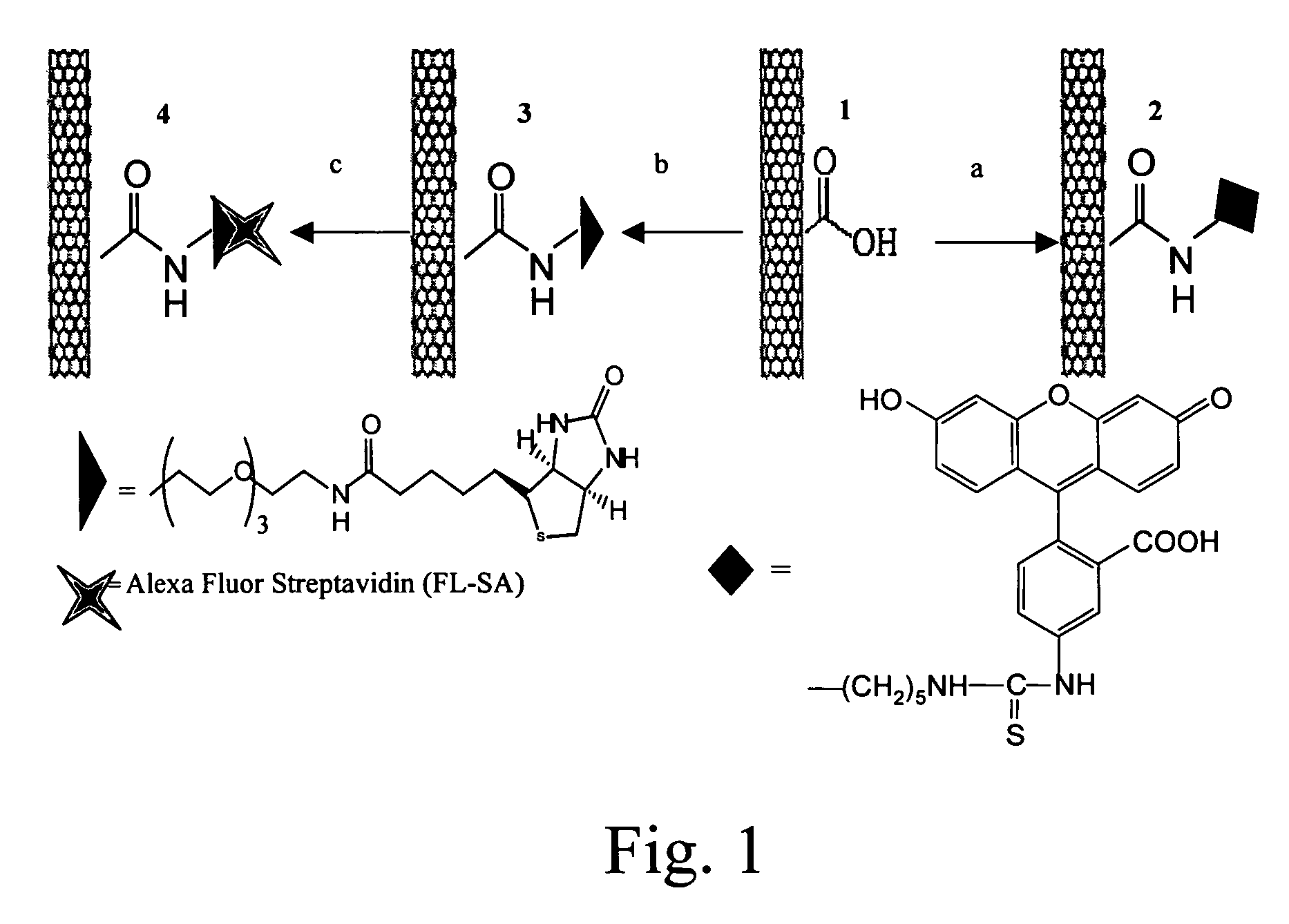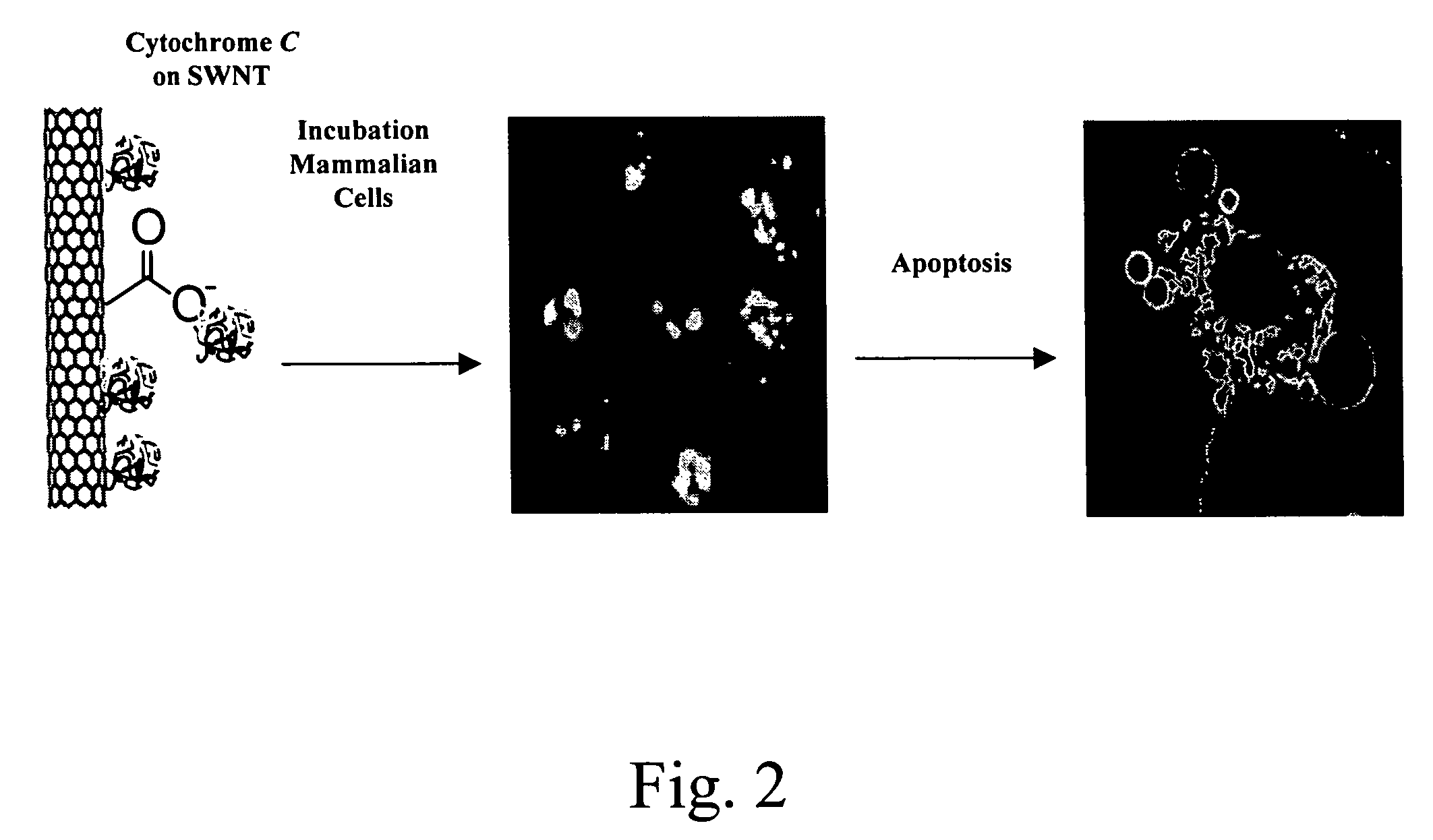Hydrophobic nanotubes and nanoparticles as transporters for the delivery of drugs into cells
a nanoparticle and hydrophobic technology, applied in the field of nanoparticles, can solve the problems of carbon nanotubes by themselves not soluble in aqueous systems, difficult dissociation of complexes, and and achieve poor cellular uptake or bioavailability. , poor cellular uptake
- Summary
- Abstract
- Description
- Claims
- Application Information
AI Technical Summary
Benefits of technology
Problems solved by technology
Method used
Image
Examples
examples 1-8
Internalization of Carbon Nanotube—Protein Conjugates Comprising Oxidized SWNT-Biotin-Strepavidin Complexes
[0086]Examples 1-8 below describe experiments conducted in accordance with FIG. 1.
[0087]FIG. 1 shows the synthesis and schematic of various SWNT conjugates. The complexes are labeled, left to right, 4, 3, 1, 2. The complex starts as 1. Then, in step a, it is reacted with EDC, 5-(5-aminopentyl)thioureidyl fluorescein, phosphate buffer to yield 2. In step b, 1 is reacted with EDC, biotin-LC-PEO-amine, phosphate buffer to yield 3; in step c, 3 is reacted with fluoresceinated streptavidin to yield 4. Examples 1-10 present our findings on the uptake of single walled nanotubes (SWNT) and SWNT-streptavidin (a protein with clinical applications in anticancer therapies (Hussey, S. L.; Peterson, B. R. J. Am. Chem. Soc. 2002, 124, 6265-6273)) conjugates into human promyelocytic leukemia (HL60) cells and human T cells (Jurkat) via the endocytosis pathway. The results described below with H...
example 1
Preparation, Oxidation and Cutting of SWNT
[0092]Stable aqueous suspensions of purified, shortened and functionalized nanotubes were obtained by oxidation and sonication (Chen, J.; Hammon, M. A.; Hu, H.; Chen, Y. S.; Rao, A. M.; Eklund, P. C.; Haddon, R. C. Science 1998, 282, 95-98; Liu, J.; Rinzler, A. G.; Dai, H.; Hafner, J. H.; Bradley, R. K.; Boul, P. J.; Lu, A.; Iverson, T.; Shelimov, K.; Huffman, C. B.; Rodriguez-Macias, F.; Shon, Y.-S.; Lee, T. R.; Colbert, D. T.; Smalley, R. E. Science 1998, 280, 1253-1256). of laser ablated SWNT. Specifically, SWNTs were refluxed in 2.5 M HNO3 for two 36 h periods separated by cup-horn sonication for 30 min. The resulting mixture was then filtered through a 100 nm pore size polycarbonate filter, rinsed and re-suspended in pure water with sonication. Centrifugation (7000 rpm, 5 min) removed larger unreacted impurities from the solution to afford a stable suspension of 1.
[0093]Analysis of 1 by atomic force microscopy revealed mostly short (˜10...
example 2
Nanotube Characterization
[0096]Nanotubes undergone the acid treatment above were characterized by atomic force microscopy (AFM) and zeta potential measurements. For AFM, a silica substrate was first treated with (3-aminopropyl)-triethoxysilane (APTES, Aldrich) to render the surface positively charged. A drop of the nanotube suspension was placed on the substrate and kept for 15 min before blow-dry. The substrate was then imaged by an AFM operated in the tapping mode (Digital Instruments). Zeta potential was measured with a ZetaPALS instrument (Brookhaven Instruments Corporation).
[0097]The acid treatment process used here was modified from previous methods (Chen and Liu) and had three main effects to the starting raw SWNT material, namely, purification, cutting of nanotubes and functionalization of nanotube sidewalls with oxygen groups. The latter affords water solubility and reactivity towards further conjugation of other molecules to the nanotubes. Reflux in nitric acid breaks down...
PUM
| Property | Measurement | Unit |
|---|---|---|
| diameter | aaaaa | aaaaa |
| diameter | aaaaa | aaaaa |
| diameter | aaaaa | aaaaa |
Abstract
Description
Claims
Application Information
 Login to View More
Login to View More - R&D
- Intellectual Property
- Life Sciences
- Materials
- Tech Scout
- Unparalleled Data Quality
- Higher Quality Content
- 60% Fewer Hallucinations
Browse by: Latest US Patents, China's latest patents, Technical Efficacy Thesaurus, Application Domain, Technology Topic, Popular Technical Reports.
© 2025 PatSnap. All rights reserved.Legal|Privacy policy|Modern Slavery Act Transparency Statement|Sitemap|About US| Contact US: help@patsnap.com



